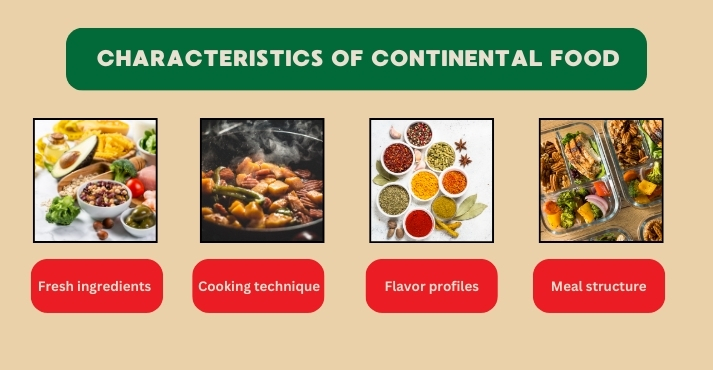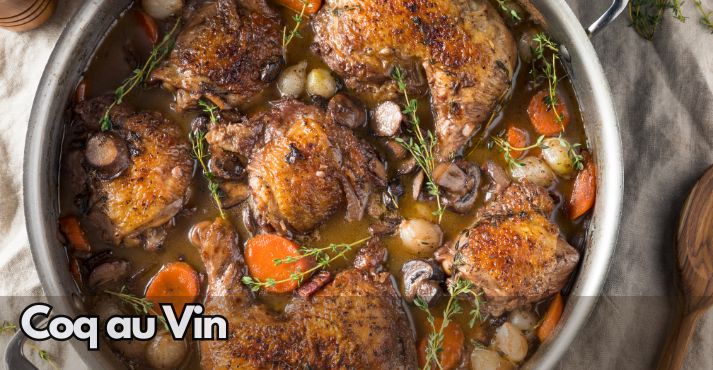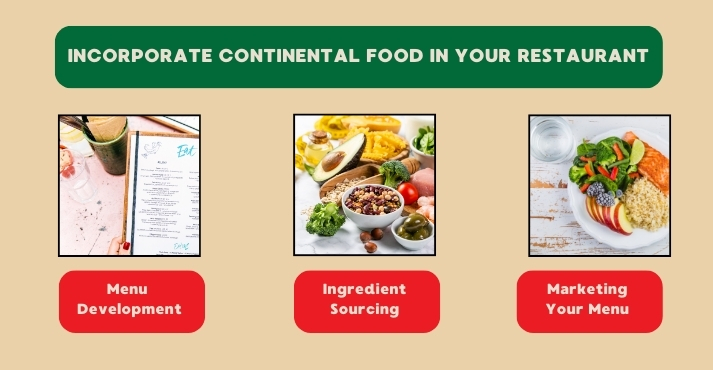Continental food, a term commonly used to describe a broad range of European cuisine, has become a staple in restaurants worldwide. This culinary tradition is known for its rich flavors, sophisticated presentation, and use of high-quality ingredients.
From the delicate pastries of France to the hearty dishes of Germany, Continental cuisine offers something for every palate.
Whether you’re a seasoned foodie or new to this style of dining, understanding the basics of Continental food can increase your appreciation for these global flavors.
This article explores continental food, its origins, key characteristics, and some popular dishes that define this culinary style.
What is Continental Food?
Continental food refers to the various cuisines of Europe, particularly those from Western and Central Europe.
This culinary style is rooted in the traditions and practices of countries like France, Italy, Spain, and Germany. The term “Continental” typically excludes the food from the British Isles and Eastern Europe, focusing instead on the food traditions of mainland Europe.
Continental cuisine‘s origins can be traced back to the Middle Ages when different regions developed distinct culinary identities.
Over time, these culinary traditions have been refined and passed down through generations, resulting in the diverse array of Continental dishes we enjoy today.
Continental food’s distinctive qualities include a focus on fresh, high-quality ingredients, focused preparation techniques, and a balanced combination of flavors and textures.
Key Characteristics of Continental Cuisine

Continental cuisine celebrates European culinary traditions. Each dish tells a story about its region’s history, culture, and agricultural bounty.
Understanding the key characteristics of Continental food increases one’s appreciation for these dishes and provides insights into why they have become beloved worldwide.
Below, we look into the defining elements that make Continental cuisine unique and enduring.
1. Emphasis on Fresh Ingredients
One of the bases of Continental cuisine is its unwavering commitment to fresh, seasonal ingredients. This culinary tradition places great importance on sourcing the ripest fruits, the freshest vegetables, and the finest cuts of meat.
Whether plump, sun-ripened tomatoes are used in an Italian pasta dish or tender, marbled beef in a French stew, the quality of ingredients is considered the foundation of a great dish.
This emphasis on freshness develops the flavor and reflects the diverse agricultural practices and regional specialties across Europe.
- Seasonal Focus: Dishes often change with the seasons, showcasing the best ingredients available at any given time.
- Regional Specialties: Local ingredients, from Italy’s truffles to Normandy’s butter, are celebrated.
2. Cooking Techniques
Continental cooking is rooted in time-honored and innovative techniques that bring out the best in each ingredient. Grilling, roasting, sautéing, and stewing are among the most common methods, each offering a different way to boost flavor and texture.
These techniques are often combined to create dishes that are not only flavorful but also visually appealing.
- Grilling: Adds a smoky flavor and crisp texture, ideal for meats and vegetables.
- Roasting: Slowly cook ingredients, allowing flavors to deepen and develop.
- Sautéing: Quick cooking at high heat, perfect for sealing in the flavors of meats and vegetables.
- Stewing: Slow cooking in liquid, ideal for creating rich, hearty dishes with tender meat and vegetables.
These techniques are integral to Continental cuisine. They allow chefs to highlight their ingredients’ natural flavors, creating simple and sophisticated dishes.
3. Flavor Profiles
Continental food has varied flavor profiles, depending on where it comes from. Some dishes taste soft and light, while others are strong and bold. For example, French food is famous for its creamy sauces and rich flavors.
On the other hand, Italian dishes often highlight the natural taste of ingredients, using minimal seasoning to allow the flavors to shine through.
- French Cuisine: Rich sauces like béchamel and hollandaise add depth to dishes.
- Italian Cuisine: Fresh herbs like basil and oregano enhance the natural taste of ingredients.
- Mediterranean Influence: Garlic, olive oil, and herbs are staples in Mediterranean dishes, adding a fresh, vibrant flavor.
4. Meal Structure
A traditional Continental meal is planned carefully and has several courses that go well together. This lets people enjoy different tastes and textures, making the meal enjoyable and easy to remember.
- Appetizer: The meal typically begins with a light appetizer, such as a salad or soup, to increase the appetite.
- Main Course: The meal’s centerpiece, often featuring a protein like meat or fish, accompanied by vegetables or starches.
- Dessert: The meal concludes with a sweet treat, such as a tart, pudding, or cake, providing a satisfying end to the dining experience.
Popular Continental Dishes: A Global Taste

Continental cuisine offers a delightful culinary experience across Europe, with each country contributing unique flavors and culinary traditions.
These iconic dishes define their respective cultures and have gained worldwide recognition, becoming favorites in restaurants and homes.
Let’s explore some of the standout dishes that showcase the diversity and richness of Continental foods.
1. French Cuisine

France is often considered the center of Continental cuisine and is known for its sophisticated and refined culinary traditions. Some of the most iconic French dishes include:
- Coq au Vin: A classic dish featuring chicken slow-cooked in red wine, mushrooms, and garlic, focusing on France’s love for hearty, flavor-packed meals.
- Boeuf Bourguignon: Another slow-cooked masterpiece, this beef stew is simmered in red wine with onions, mushrooms, and bacon, offering rich, complex flavors.
- Crème Brulee is a beloved dessert known for its creamy custard base topped with a perfectly caramelized sugar crust, which symbolizes indulgence and elegance.
2. Italian Cuisine

Italy’s contribution to Continental food is vast and widely celebrated, with pasta and pizza being two of the most recognizable exports. Essential Italian dishes include:
- Spaghetti Carbonara: A creamy pasta dish made with eggs, cheese, pancetta, and pepper, showcasing Italy’s ability to create comfort food with simple ingredients.
- Lasagna: Layers of pasta, rich meat sauce, bechamel, and cheese baked to perfection, this dish is a global favorite for its hearty and comforting flavors.
- Risotto: A creamy rice dish often prepared with broth, wine, and various ingredients like mushrooms or seafood, showcasing the versatility of Italian cuisine.
3. German Cuisine

Germany’s culinary traditions bring flavorful and satisfying dishes to the Continental dining experience. Some of the most famous German dishes include:
- Schnitzel: A breaded and fried cutlet, usually made from pork or veal, is a staple in German households and a favorite in many restaurants.
- Sauerbraten is a pot roast typically marinated for several days in vinegar or wine, spices, and seasonings. It offers tangy and highly flavorful meat.
- Spatzle: Soft egg noodles are often served as a side dish; Spatzle pairs perfectly with hearty German meals, soaking up sauces and adding to the overall dining experience.
4. British Cuisine

While often associated with the British Isles, certain British dishes have become integral to Continental cuisine due to their popularity. Notable dishes include:
- Fish and Chips: A simple yet iconic meal of battered fish served with crispy fries, beloved in many countries for its straightforward, satisfying flavors.
- Shepherd’s Pie: A comforting dish made with ground meat topped with mashed potatoes, baked until golden, offering a warm, hearty meal.
- Yorkshire Pudding: A savory pastry typically served alongside roast meats, Yorkshire Pudding is an essential part of British culinary tradition.
5. Spanish Cuisine
Spain adds a vibrant and flavorful dimension to Continental foods with bold and diverse dishes. Essential Spanish dishes include:
- Paella: A celebrated rice dish infused with saffron and typically loaded with seafood, chicken, or rabbit, offering a taste of Spain’s coastal and agricultural offerings.
- Tapas are small plates for sharing that feature a variety of flavors, from spicy chorizo to marinated olives. They are perfect for social dining.
- Jamon Iberico: A prized dry-cured ham representing Spain’s rich culinary heritage, known for its delicate flavor and melt-in-the-mouth texture.
Tips for Incorporating Continental Cuisine in Your Restaurant

Incorporating Continental cuisine into your restaurant’s menu can add to your offerings and attract a wider customer base.
The richness and diversity of Continental foods provide endless possibilities for creating a memorable dining experience. Here are some tips to help you successfully integrate these dishes into your restaurant menu.
1. Menu Development
Creating a balanced menu that reflects the essence of Continental food is crucial. Start by selecting a variety of dishes that showcase different aspects of Continental cuisine, mainly if you are operating a full-service restaurant.
For example, you might include French appetizers like a classic French Onion Soup, Italian main courses such as Spaghetti Carbonara, and a decadent Creme Brulee for dessert.
By offering a range of dishes from various European countries, you can cater to varied tastes while maintaining the authenticity of Continental dining.
2. Ingredient Sourcing
The quality of ingredients is principal in Continental cooking. To truly capture the essence of these dishes, it’s essential to source high-quality, authentic ingredients.
For instance, using fresh, locally sourced produce and premium meats will ensure that your dishes reflect the authentic flavors of Continental foods.
In regions like Southeast Asia, where certain European ingredients may be harder to find, you can explore local markets or specialty stores that import products from Europe.
3. Marketing Your Menu
Once your menu is ready, the next step is effectively marketing your Continental cuisine to attract customers. Highlight the uniqueness of your offerings by hosting themed nights focused on specific countries, like a French or Italian night.
Emphasizing authentic ingredients and traditional cooking techniques can also be a selling point. To stand out, you can also utilize digital marketing tactics.
Conclusion
Continental cuisine offers a rich and varied culinary experience that can upgrade any restaurant’s menu. Understanding what is continental food and its key characteristics allows you to create dishes that taste great and provide an authentic dining experience.
To bring out the best in these continental dishes, it’s essential to use high-quality ingredients and create a balanced menu with different flavors and textures.
With these tips, you can ensure your restaurant stands out and keeps people returning for more.













